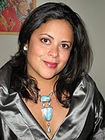- Indonesian American
-
Indonesian American Maya Soetoro-Ng · Mark-Paul Gosselaar Total population 95,270 as of 2010 Regions with significant populations Southern California Languages Religion Christianity, Islam, others
Indonesian Americans comprise immigrants from the multiethnic country of Indonesia to the United States, and their U.S.-born descendants.[1] As of the 2000 United States Census, they were the 15th largest group of Asian Americans.[2] That census showed 63,073 people who identified themselves as Indonesians residing in the United States.[2]
Contents
Migration history
Indonesian international students came to the United States in significant numbers as early as the mid-1950s, beginning with a 1953 International Cooperation Administration (now U.S. Agency for International Development) program to allow University of Indonesia medical faculty to pursue higher studies at the University of California, Berkeley.[1] Permanent settlement in the U.S. began to grow in 1965, due to the Immigration and Nationality Act of 1965, which opened the door to Asian migration, and the violent and chaotic Transition to the New Order in Indonesia, which spurred emigration from that country.[3] Between 1980 and 1990, the number of Indonesians in the United States tripled, reaching 30,085.[4] A large proportion live in Southern California: 29,710 respondents to the 2000 census who listed "Indonesian" as one of their ethnicities lived there.[3]
Active lobbying of politicians by Chinese American groups contributed to an unusually high number of successful Chinese Indonesian applicants for political asylum to the United States in 1998. According to the U.S. Department of Justice, 7,359 applicants were granted asylee status and 5,848 were denied in the decade up to 2007. In recent years, however, it has become increasingly difficult for applicants to prove to immigration officials that they would face targeted violence if returned to Indonesia.[5]
In 2004, the U.S. Court of Appeals for the Ninth Circuit ruled in Sael v. Ashcroft that a Chinese Indonesian couple was eligible for political asylum after citing the existence of anti-Chinese violence and of laws that prohibit Chinese schools and institution.[6][7] The same court in the following year granted Marjorie Lolong eligibility for asylum after finding that she is "a member of [women and Christian] sub-groups that are at a substantially greater risk of persecution than the [ethnic Chinese] group as a whole".[8] However, the court reversed its findings through an en banc decision and stated that it understood the Board of Immigration Appeals' (BIA) "decision to preclude a general grant of asylum to Indonesian Chinese Christians". The dissenting opinion criticized the BIA's rejection of testimony regarding the Indonesian government's inability to control persecution despite its intentions.[9]
Demography
Ethnicity
The first Indonesians to move to Southern California were Indos (Indonesians of mixed pribumi and European descent).[10] However, the majority of Indonesians who came in the 1960s were of Chinese descent.[11] Unofficial estimates suggest that as many as 60% of the Indonesians in Southern California are of Chinese descent.[12] Interracial marriage is not uncommon, especially among the young, though the elderly often prefer that their children marry other Indonesians.[13]
Religion
A large proportion of Indonesians in the U.S. are Christian, though Muslims are also present.[12] The first Indonesian church in the U.S. was a Seventh-day Adventist Church established in Glendale, California in 1972 with a predominantly Indo congregation; however, as more pribumi migrants joined the church, racial tensions arose, and the Indos withdrew to other churches. The second Indonesian church to be founded in the U.S. was a Baptist church, started by an ethnic Chinese pastor and with a predominantly ethnic Chinese congregation.[14] By 1988, there were 14 Indonesian Protestant congregations; ten years later, that number had grown to 41, with two Indonesian Catholic congregations as well.[15]
Media
Indonesians have founded a number of publications in California. The earliest was the Indonesian Journal, founded in 1988, and published primarily in the Indonesian language.[4] Others include the Loma Linda-based Actual Indonesia News (founded 1996, also in Indonesian), and the Glendora-based Indonesia Media (founded 1998).[4] Los Angeles-based monthly The Indonesia Letter has the largest circulation.[16]
See also
References
Notes
- ^ a b Yang 2001, pp. 898–899
- ^ a b Barnes & Bennett 2002, p. 9
- ^ a b Cunningham 2009, p. 93
- ^ a b c Cunningham 2009, p. 92
- ^ Sukmana 2009
- ^ Egelko, Bob (15 October 2004), "Ethnic Chinese from Indonesia wins appeal", San Francisco Chronicle: p. A2, http://www.sfgate.com/cgi-bin/article.cgi?file=/c/a/2004/10/15/MNGRV9AHH31.DTL, retrieved 26 January 2010
- ^ Sael v. Ashcroft, 386 F.3d 922 (9d Cir. 14 October 2004).
- ^ Lolong v. Gonzales, 400 F.3d 1215 (9d Cir. 18 March 2005).
- ^ Lolong v. Gonzales, 484 F.3d 1173 (9d Cir. 7 May 2007).
- ^ Cunningham 2009, p. 97
- ^ Yang 2001, p. 899
- ^ a b Cunningham 2009, p. 95
- ^ Yang 2001, p. 902
- ^ Cunningham 2009, pp. 97–98
- ^ Cunningham 2009, p. 98
- ^ Yang 2001, p. 904
Sources
- Yang, Eveline (2001), "Indonesian Americans", in Lehman, Jeffrey, Gale Encyclopedia of Multicultural America, 2 (second ed.), Gale Group, pp. 897–905, ISBN 9780787639860
- Barnes, Jessica S.; Bennett, Claudette E. (February 2002), The Asian Population: 2000, U.S. Census 2000, U.S. Department of Commerce, http://www.census.gov/prod/2002pubs/c2kbr01-16.pdf, retrieved 2009-09-30
- Cunningham, Clark E. (2009), "Unity and Diversity among Indonesian Migrants to the United States", in Ling, Huping, Emerging Voices: Experiences of Underrepresented Asian Americans, Rutgers University Press, pp. 90–125, ISBN 9780813543420
- Sukmana, Damai (January 2009), "Game of Chance: Chinese Indonesians Play Asylum Roulette in the United States", Inside Indonesia 95, ISSN 0814-1185, http://www.insideindonesia.org/content/view/1164/47/, retrieved 31 January 2010
Further reading
- Wijaya, Juliana (2006), "Indonesian Heritage Learners’ Profiles: A Preliminary Study of Indonesian Heritage Language Learners at UCLA", Journal of Southeast Asian Language Teaching 12: 1–14, http://www.seasite.niu.edu/jsealt/Volume12Spring2006/Articles/Juliana%20PDF.pdf
External links
- Indonesian American Association - Ikatan Keluarga Indonesia
- US Census 2000 foreign born population by country
Asian Americans East Asian 
South Asian2 Southeast Asian Other History 1 The US Census Bureau reclassifies anyone identifying as "Tibetan American" as "Chinese American". [1].
2 The US Census Bureau considers Afghanistan a South Asian country, but does not classify Afghan Americans as Asian. [2]Overseas Indonesians Africa Egypt · South Africa
Americas Asia Hong Kong · Japan · Philippines · Saudi Arabia · Singapore · South Korea · Sri Lanka · Taiwan · United Arab EmiratesEurope Oceania Others Categories:- American people of Asian descent
- American people of Indonesian descent
- Ethnic groups in the United States
- Indonesian diaspora
- Indonesian emigrants to the United States
Wikimedia Foundation. 2010.


